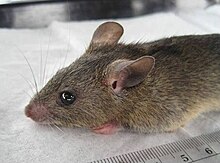Natal multimammate mouse
| Natal multimammate mouse | |
|---|---|

| |
| Scientific classification | |
| Domain: | Eukaryota |
| Kingdom: | Animalia |
| Phylum: | Chordata |
| Class: | Mammalia |
| Order: | Rodentia |
| Family: | Muridae |
| Genus: | Mastomys |
| Species: | M. natalensis
|
| Binomial name | |
| Mastomys natalensis Smith, 1834
| |
| Synonyms | |
| |
TheNatal multimammate mouse(Mastomys natalensis) is a species ofrodentin the familyMuridae.It is also known as theNatal multimammate rat,the commonAfricanrat, or theAfrican soft-furred mouse.[1]The Natal multimammate rat is the natural host of theLassa fever virus.
Range
[edit]It is found inAfrica south of the Sahara.Six different genetic groups can be distinguished in different regions: one in western Africa, one in central Africa, one in southern Africa and three in eastern Africa.[2]

Habitat
[edit]Its naturalhabitatsaresubtropical or tropical dry forest,subtropical or tropical moist lowland forest,drysavanna,moist savanna, subtropical or tropical dryshrubland,subtropical or tropical moist shrubland,arable land,pastureland, rural gardens,urban areas,irrigated land, and seasonally flooded agricultural land.
These rats associate closely with humans, and are commonly found in and around African villages.
Interactions with humans
[edit]The species has been used as alaboratory animalsince 1939. It has great value for researchers who focused on stomach cancer and spontaneous tumors. It is also the most important reservoir ofLassa fever virus.[3]
References
[edit]- ^"Multimammate Mice".Archived fromthe originalon 2009-02-07.Retrieved2009-07-14.
- ^Colangelo, Paolo (2013)."A mitochondrial phylogeographic scenario for the most widespread African rodent, Mastomys natalensis".Biological Journal of the Linnean Society.108(4): 901–916.doi:10.1111/bij.12013.
- ^Clive Roots;Domestication- page: 115
External links
[edit]- Granjon, L., Lavrenchenko, L., Corti, M., Coetzee, N. & Rahman, E.A. 2004.Mastomys natalensis.2006 IUCN Red List of Threatened Species.Downloaded on 9 July 2007.
- Musser, G. G.;Carleton, M. D. (2005)."Superfamily Muroidea".InWilson, D. E.;Reeder, D. M. (eds.).Mammal Species of the World: A Taxonomic and Geographic Reference(3rd ed.).Johns Hopkins University Press.p. 1365.ISBN978-0-8018-8221-0.OCLC62265494.
- Tofts, Russell.Multimammate Mice.Retrieved July 14, 2009.

